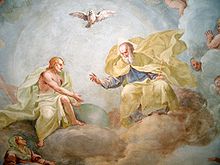The Trinity is one of the distinctive doctrines of Christianity. It goes hand in hand with the doctrine of the Incarnation, since if Jesus Christ was God, and at the same time the Son of God, there must be a distinction between God and God. The implications were worked out several centuries after the resurrection and ascension of Christ, giving Unitarians the opportunity to argue that the doctrine was a mere human invention. I think it can be shown that Scripture does imply and even teach the Christian Trinity. But does the doctrine make sense, metaphysically? As I wrote previously, the Sufi author of The Transcendent Unity of Religions, Frithjof Schuon, does not think so.
Schuon writes in Christianity/Islam (p. 97): “what Islam blames Christianity (not the Gospels) for is not that it should admit of a Trinity within God, but that it should place this Trinity on the same level as the divine Unity; not that it should attribute to God a ternary aspect, but that it should define God as triune, which amounts to saying either that the Absolute is triple or else that God is not the Absolute.”
But if this is what Islam thinks, then Islam blames Christianity for a sin it does not commit. The Church teaches that the Absolute is both One and Three, but not in the numerical sense, not “triple”, as if one could place the three Persons side by side and count them. As Meister Eckhart writes in his Commentary on Exodus, “God is one, outside and beyond number, and is not counted with anything”, and adds that in the Godhead “the same essence and the same act of existence which is the Paternity is the Sonship: the Father is what the Son is. Nevertheless, the Father himself is not the Person who is the Son, nor is the Paternity the Sonship.” Eckhart’s teaching is implied in this simple statement by St Augustine, cited by Joseph Ratzinger in his classic Introduction to Christianity (p. 183): “He is not called Father with reference to himself but only in relation to the Son; seen by himself he is simply God.” The Trinity is not a view of God from the outside – despite its symbolic depiction in Christian art – but is a secret of his interior life, of his relations with himself.
Islam’s inability to grasp all this is, of course, perfectly understandable. It cannot be grasped. We cannot “know” the Trinity, for the Trinity itself is something we can only accept in faith as Eckhart did, by assenting to the revelation of the Word. If a Muslim assented to that revelation, he would become a Christian. We can never get “outside” the Trinity in order to grasp it as an object. It is within the Trinity that we ourselves are grasped and understood, and “then I shall understand fully, even as I have been fully understood” (1 Cor. 13:12), but not otherwise.
If you like, read my "Face to Face: The Difference Between Christian and Hindu Non-Dualism".
Illustration: Holy Trinity, by Luca Rossetti da Orta, 1738-9, from Wikimedia.

No comments:
Post a Comment